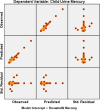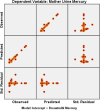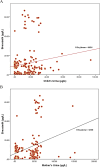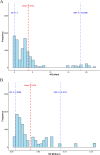Mercury poisoning in women and infants inhabiting the Gangetic plains of Bihar: risk assessment
- PMID: 40186162
- PMCID: PMC11971891
- DOI: 10.1186/s12889-025-22336-9
Mercury poisoning in women and infants inhabiting the Gangetic plains of Bihar: risk assessment
Abstract
Mercury is a persistent, bio-accumulative, and hazardous contaminant. When released into the environment, it accumulates in water sediments, converting it to poisonous methylmercury that enters the food chain. The present study was carried out in habitations from the 11 districts of Bihar (India). In the study, n = 224 lactating women and their infants n = 172 infants participated. After obtaining the written informed consent, their breast milk, urine, and blood were collected for mercury estimation. The breastmilk content was measured in n = 181 subjects, in which 74% women had their breastmilk higher than the WHO permissible limit (< 1.7 μg/L), while 26% of the women had their breast milk below the permissible limit. The blood mercury content showed that 19% subjects had mercury content above the permissible limit [20 μg/L]. In urine mercury estimation, 49% women had mercury content above the permissible limit [10 μg/L], while, 51% women had the mercury content below the permissible limit. In the child's urine, 54% infants had their mercury content in urine above the permissible limit [10 μg/L] while 46% infants had content below the permissible limit. The study indicates that 20% of infants had the complete accumulation of mercury in their body which is highly toxic for them. However, the mercury content in the food (wheat) had the contamination with in the permissible limit [100 μg/kg]. There was a significant correlation found between the breastmilk and child's urine and mother's urine. The HQ study also correlates the mercury poisoning effect with 100% of the mother's and 66% of the infants exceeding the limit of non-carcinogenic risk. The Monte Carlo and multivariate study correlates the high health risk in the studied population due to mercury poisoning. The entire study concludes that population inhabitation in the Gangetic plains of Bihar are exposed to mercury poisoning which may be due to geogenic or anthropogenic sources. But, the levels of mercury contamination above the permissible limit could lead to neurogenerative changes in the lactating mothers and their infants. To control the present problem medical intervention is immediately required.
Keywords: Breastmilk; Geospatial mapping; Infants; Lactating mothers; Mercury poisoning.
© 2025. The Author(s).
Conflict of interest statement
Declarations. Ethics approval and consent to participate: Ethical clearance was granted with IEC Letter No. RMRI/EC/24/2020 dated September 26, 2020, by the Institutional Ethics Committee of the Indian Council of Medical Research Unit—Rajendra Memorial Research Institute of Medical Sciences (MoU for Ethics approval), Patna, Bihar, India. This approval is applicable to all aspects of the research. The objectives of the investigation were explained to all patients, and their written informed permission was acquired before the research project started. In accordance with the “WMA Declaration of Helsinki-Ethical Principles for Medical Research Involving Human Participants 2024” [36] the ethical standards outlined, as well as those of the Indian Council of Medical Research, Government of India, were strictly observed to throughout the duration of the study. The authors provide permission for any clarification pertaining to the article's publishing. Consent for publication: Not applicable. Competing interests: The authors declare no competing interests.
Figures















Similar articles
-
Lead exposure in Bihar, Eastern India: a risk assessment study.Environ Geochem Health. 2025 Aug 10;47(9):368. doi: 10.1007/s10653-025-02687-3. Environ Geochem Health. 2025. PMID: 40783904
-
High lead contamination in Mother's breastmilk in Bihar (India): Health risk assessment of the feeding children.Chemosphere. 2024 Sep;364:143064. doi: 10.1016/j.chemosphere.2024.143064. Epub 2024 Aug 12. Chemosphere. 2024. PMID: 39142396
-
High arsenic contamination in the breast milk of mothers inhabiting the Gangetic plains of Bihar: a major health risk to infants.Environ Health. 2024 Sep 20;23(1):77. doi: 10.1186/s12940-024-01115-w. Environ Health. 2024. PMID: 39304890 Free PMC article.
-
[The toxicological estimation of the heavy metal content (Cd, Hg, Pb) in food for infants and small children].Z Ernahrungswiss. 1990 Mar;29(1):54-73. doi: 10.1007/BF02019535. Z Ernahrungswiss. 1990. PMID: 2185600 Review. German.
-
Mercury and lead during breast-feeding.Br J Nutr. 2004 Jul;92(1):21-40. doi: 10.1079/BJN20041163. Br J Nutr. 2004. PMID: 15230985 Review.
References
-
- Gonzalez-Raymat H, Liu G, Liriano C, Li Y, Yin Y, Shi J, Jiang G, Cai Y. Elemental mercury: Its unique properties affect its behavior and fate in the environment. Environ Pollut (Barking, Essex : 1987). 2017;229:69–86. 10.1016/j.envpol.2017.04.101. - PubMed
-
- Loredana Ungureanu E, Mustatea G. Toxicity of heavy metals. IntechOpen. 2022. 10.5772/intechopen.102441.
MeSH terms
Substances
Grants and funding
LinkOut - more resources
Full Text Sources
Medical

